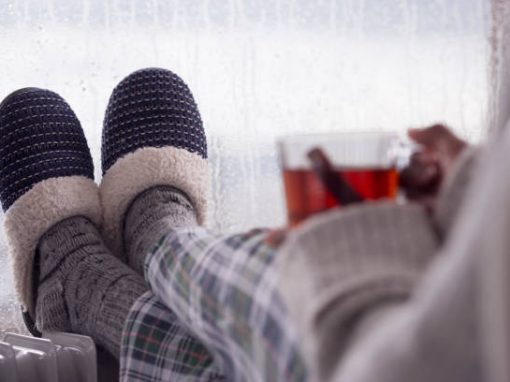WINTER FOOT CARE TIPS

Winter in Canada is cold, snowy and icy and rainy! It is important to take certain precautions to ensure that your feet stay warm and dry. This is particularly important to those people in higher risk groups, such as diabetics, those with poor circulation, have medical conditions such as Raynaud’s disease, or whom may be more susceptible to damage from falls. Here are some tips that will keep your feet looking and feeling healthy this winter, and keep you going into spring and summer!
1. Keep Your Feet Clean and Dry
Winter boots and wool socks will keep your feet warm and toasty, but it may also cause them to sweat a lot. Damp feet get cold more easily and are prone to bacterial and viral infections. Foot powder can help keep your feet clean and dry.
Treat yourself to Epsom salt footbaths throughout the cooler weather, and dry your feet thoroughly after each footbath. Pay special attention to areas between the toes.
It is also wise to wear socks made of moisture-wicking material, where moisture is taken away from the skin. Extra moisture can also cause the skin to cool down more quickly and potentially lead to frostbite. Many companies even make socks with infused silver or copper, which are quite helpful in keeping heat in and moisture and bacteria away. Materials such as merino wool are great for keeping warm and wicking moisture at the same time.
2. Wear Comfortable Boots
Wear boots that fit comfortably and that aren’t too tight. Tight footwear can decrease blood flow, making it harder to keep your feet warm, increasing the risk of frostbite, or flaring up conditions such as Chilblains and Raynaud’s.
You should be able to wiggle your toes, but your heel, instep, and the ball of your foot should be sturdy in your shoe. Boots should have a solid base, supportive heel, and laces or straps to ensure that you’re able to remain stable on wet and slippery surfaces. It is also important to inspect the tread on the boot. You want to make sure it has good traction and will hold well on snow and ice.
If you are purchasing winter gear for your children, such as winter boots, skates, or ski boots, avoid the temptation to buy a larger size in order to get two seasons of wear out of the shoes. It is crucial for footwear to fit properly right away in order to prevent chafing, blisters, and foot injuries.
3. Dry Your Winter Boots and Shoes Out
Before going back outside in your boots or shoes again, be sure to dry them out thoroughly. Doing this will help prevent your feet from getting cold quickly as well as prevent the growth of fungi and bacteria. Even better — have 2 pairs, and alternate them each day.
4. Wash Your Feet Every Day
Wash your feet daily. Keeping feet clean can prevent toenail fungus and other unpleasant problems.
Make sure that your feet are completely dry before you put socks and shoes on again. Change socks daily.
It is also a good idea to soak your feet in Epsom salt and warm water periodically to relieve discomfort and prevent infections. Be sure to remember to keep it to 10 minutes maximum per session.
5. Take Care of Your Skin
Cold weather means less humid air, which means less moisture for your skin and nails. When your skin dries out, it splits and can lead to painful fissures, increased pain and chances of infection. Skin problems can be particularly troublesome for people with diabetes or those with impaired circulation.
Remember to use a good moisturizer daily, not just when your skin looks like you need it. As a result, your skin will be supple and smooth. If possible, apply moisturizer shortly after a bath or shower, it will soak in better and have a more significant overall effect.
Remember, it is a lot easier to maintain good skin than it is to fix a problem.
